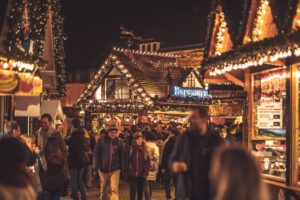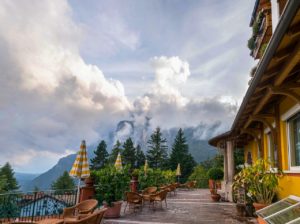As residents of South Africa, we are blessed with the privilege of experiencing some of the most delightful weather conditions all year round. Our summer season is characterized by warm temperatures that beckon us to enjoy outdoor activities and bask in the sun’s warmth for hours on end. Meanwhile, the winter season is relatively short, although it is by no means unenjoyable, with mild and comfortable conditions that make it easy to still get out and about. One of the unique features of South Africa’s climate is the similarity in day lengths throughout the year, meaning we get to experience the same amount of sunlight throughout the seasons. Our houses are built to keep the heat out and we suffer through the two relatively cold months of July and August with extra blankets, heaters, jerseys and OBS.
During the winter months in Germany, the challenges are different but no less significant. The darkness sets in earlier and lasts for longer periods of time, making it challenging to find the motivation to stay active and engaged. Most houses have central heating which makes it nice and warm inside, but outside it can be wet, cold and windy making it more difficult to keep warm. Despite these challenges, we find ways to adapt, whether it’s through bundling up with extra layers or finding indoor activities to stay occupied. Like most Germans will tell you, there is no such thing as bad weather, only bad clothes. Overall, each season brings its own set of challenges, but with a little bit of preparation and adaptation, we can make the most of even the most difficult weather conditions.
It’s important to approach the season with a positive and open mindset. Instead of dreading the colder temperatures and shorter days, try to embrace the unique changes that winter brings. For example, take advantage of winter sports like skiing and ice skating, or enjoy cozy nights indoors with warm drinks and hearty meals.
Below is a summary of each month, and a link to our individual pages for each month where you find a range of topics, including upcoming holidays, weather predictions, what foods are in season, and popular events that are happening.
October
As we enter the month of October in Germany, we are greeted with vibrant autumn foliage and a nip in the air that heralds the onset of cooler temperatures. The crisp air is invigorating, and one can’t help but be overcome by the beauty of nature as the leaves begin to change and the landscape transforms into a kaleidoscope of colors. This time of year is perfect for outdoor activities like bike rides or hikes through the countryside. Germany also offers a host of autumn festivities such as Oktoberfest, pumpkin festivals, and wine tastings, which provide a chance to savor the local cuisine and culture. October in Germany is truly a delightful and unforgettable experience that should be cherished every year.

October 2023
October October in Germany can still be mild and sunny, it is then referred to as a Goldener Oktober.The leaves are turning yellow, red, orange and brown. It is the perfect time to take beautiful nature photos.If you are interested in wine, take a drive on the German wine route, which is the oldest scenic drive in Germany. You can find more information here.A boat ride along one of the large rivers, such as the Rhine or the Neckar, will reward you with spectacular autumn vineyard views.It is also a good time to go hiking, just make sure you have the correct
November
As we step into November, it’s important to keep in mind that it’s going to get colder. With winter upon us, we have turned our clocks back by one hour, making us an hour behind South Africa. While it may be sad to see the sun set earlier, there should be no despair because November is an exciting and festive month in Germany. In fact, towards the end of the month, even with the temperature drop, the fun begins. This is when the much-awaited Christmas markets spring up all around the country, for a month-long celebration of the festive season. Everywhere you go, there is a cosy atmosphere, with twinkling fairy lights, warming glühwein and delicious festive treats. So, don’t let the cold get you down, embrace the magic of the season and indulge in all the wintertime festivities Germany has to offer!

November 2023
November As we move into the month of November in Germany, we are welcomed by the chilly winds of autumn, the picturesque landscapes with trees
December
December is truly a magical time of year, filled with all things Christmas. It’s the perfect opportunity to fully embrace the holiday season and indulge in everything it has to offer. Why not head to the festive markets and soak up the atmosphere, enjoying all the delicious treats on offer, such as the delectable Lebkuchen and warming Glühwein. Take the time to gather with friends and learn about the rich German Christmas traditions that are centuries-old. Although most towns may not usually experience a white Christmas, the mountain regions have been known to be blanketed with snow, adding an extra layer of enchantment to the already festive season. So go ahead, take some time out of your busy schedule and really indulge in the joy and magic of the holidays – you won’t regret it!

December 2023
December In December the main focus is on Christmas, and the Germans have many Christmas traditions to celebrate. Christmas markets are a very big part of these traditions. Meet up

German Christmas Traditions
St. Nicholas Day St Nicholas Day, known as Nikolaustag in Germany, is celebrated on the 6th of December. Children leave a pair of cleaned boots

Christmas Markets
Visiting Christmas markets in Germany is a delightful way of celebrating the festive season. The heavy scent of sweets, fried sausage and warm wine welcome
January
Winter in Germany starts in December and lasts until March. However, January is known for being one of the coldest months throughout the country, with freezing temperatures and possible snowfall in some regions. Nonetheless, this chilly weather can be perfect for winter activities such as skiing, snowboarding, or simply enjoying a scenic walk in the mountains that are covered in a blanket of snow. It’s crucial to wear clothing that protects you from the cold such as winter woollies, winddichte Jacke, gloves, and Mütze, as the wind can make the cold even more difficult to bear. Alternatively, you could warm up in a sauna or visit an indoor swimming pool if you need a break from the cold.

January 2024
The holiday season is filled with excitement and joy, but once the festivities have ended and the New Year has begun , it can feel
February

For me this is the most difficult month, I just want winter to be over. It is getting lighter but not warmer yet. Just hang in there… almost spring. Taking a short break along the Mediterranean coast, where the weather is already warmer, could help recharge both the body and mind. Make sure you get enough sunshine if possible or talk to your health provider about taking Vitamin D tablets. Read more about SAD (Seasonal Affective Disorder) in the links at the bottom of the page

February 2024
February February is a month of great importance as it is known for love. This event is celebrated with great vigour and passion in South
March
Springtime in Germany is a beautiful sight to behold! As the weather starts to warm up, the landscape around you transforms, bursting into life with colorful blooms and blossoming trees that are sure to take your breath away. However, while the arrival of spring brings hope for warmer temperatures and sunny days, it’s essential to bear in mind that March is still a chilly month in Germany. So, before you go leaving your winter coats at home in anticipation of the spring sunshine, it’s best to keep them handy as the temperatures can change suddenly. Also, it’s good to know that the trees in Germany don’t immediately sprout leaves when spring starts; in fact, it usually takes until April before the leaves start showing up. So take some time to enjoy the flowers and the beautiful sights of nature blossoming in Germany, and remember to dress appropriately!

March 2024
Spring is finally here, but let’s not get overly excited, as temperatures will still take a few weeks to rise.Although the trees will only begin
Tips to get through the colder months
Clothing
When it comes to venturing outside during cold weather, it’s essential to make sure that you have the right attire to keep yourself warm and protected. Layering is the key to maintaining a comfortable temperature, as it allows you to adjust your clothing according to the weather conditions.
- Start with a thermal base layer made of moisture-wicking fabric that will keep sweat away from your body.
- Add an insulating layer like a fleece or down jacket to trap in heat
- Finish with a waterproof and windproof outer layer.
- Don’t forget to pay attention to your extremities, as they are susceptible to frostbite. Wear gloves, a hat and a scarf to keep your head and neck covered. If you live in windy areas make sure your headwear is windproof.
- Make sure you have sturdy footwear that provides insulation and a good grip on snowy or icy surfaces.
- Invest in Thermohose or Thermojeans. Most have a outdoor look but you do get pants that will work fine for the office as well. You can buy them at outdoor shops. C&A also sells them in winter.
- For the ladies, look for Thermo leggings or jeggins that have fleece in the inside. You can find them at shops like Tchibo, Calzedonia, Bonprix and in Drogerie shops
- Get thermal insoles for your shoes if you plan on being outside for long periods of time

Where to shop for clothes
We understand how difficult it can be to find the perfect shop where you can buy new clothes. That’s why we took the initiative to
Lack of Sunshine
Consider Light therapy which mimics natural outdoor light and appears to cause a change in brain chemicals linked to mood. You can read here more about buying the correct equipment.
Talk to your health provider about taking extra Vitamin D

Seasonal affective disorder (SAD)
Surviving winter in Germany. How to deal with Seasonal affective disorder (SAD) or feeling blue during the winter months.
Home
- Fill your home with plants you love
- Invest in warm lights
- Burn scented candles
- Play you favourite music
- Have indoor activities the whole family can partake in for example board or card games.
Activities
- It will most likely snow in the mountains and towns with a higher altitude
- Spend a weekend in a cosy cabin and enjoy the winter scenery
- Go for walks outside, learn a winter sport and keep warm with hearty food.
- Visit a Besen or Strauss – Restaurants that are open only during certain times of the year, usually at a winery (Weingut)
- Play indoor sports such as indoor soccer, squash, badminton (das Federballspiel), volleyball, handball
- Visit a wellness hotel / Spa
- Visit museums
- Go to indoor concerts and shows
- Try sledging (Rodel) at a Rodelbahn

Besenwirtschaft
A different type of Gemütlichkeit awaits you at Besen. It is a wonderful way to meet up with friends. A Besenwirtschaft, also known as a

Tourist accommodation types
Germany, known for its rich cultural heritage, stunning landscapes, and vibrant cities, offers a diverse range of accommodation options to suit every traveler’s needs. Here’s

Participating in Sports in Germany
Sports in Germany South Africans are generally a sport-crazy bunch. Not just watching it, but also actively taking part. Participating in sports here in Germany
Snow Information
Related content

Pumpkins
Pumpkin season in Germany is from July to January. In Germany, it is called Kürbiszeit Some facts about pumpkins Pumpkins belong to the Squash (Cucurbita)

Weather in Germany
German Climate Germany’s climate is temperate and marine, with cold, cloudy winters and warm summers and in the south occasional warm föhn wind. The greater

Raclette
The summer months are gone, and for most of us, it is too cold to have a braai with our friends. A great alternative is

Germany month by month
We created a page for each month so you can find out what food is in season, what public holidays and festivals you can look


You must be logged in to post a comment.